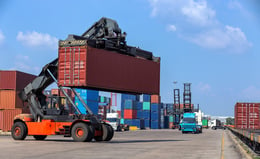How Digital Shipping Can Lower Logistics Costs
Brian Hoey - December 25, 2018

 If you sat down to compare the experience of taking a cross country road trip now vs. thirty years ago, what might come to mind? Probably, your first thought would be about how the rise of GPS systems (and, relatedly, smartphones) had made navigation much easier. Gone are the days when drivers need to purchase physical maps and chart their courses by hand. You might also think about the ways in which modern cars are better suited to this kind of journey, often featuring built-in GPS systems, Bluetooth hookups for playing music or receiving navigational instructions from your iPhone, and improved safety features like alerts if you're drifting out of your lane. All of this is undoubtedly true, but do all of these convenience-adding features also make traveling cheaper?
If you sat down to compare the experience of taking a cross country road trip now vs. thirty years ago, what might come to mind? Probably, your first thought would be about how the rise of GPS systems (and, relatedly, smartphones) had made navigation much easier. Gone are the days when drivers need to purchase physical maps and chart their courses by hand. You might also think about the ways in which modern cars are better suited to this kind of journey, often featuring built-in GPS systems, Bluetooth hookups for playing music or receiving navigational instructions from your iPhone, and improved safety features like alerts if you're drifting out of your lane. All of this is undoubtedly true, but do all of these convenience-adding features also make traveling cheaper?
It might not be the first thing that comes to mind, but it stands to reason that by taking the most efficient route (and dynamically changing that route as new traffic conditions arise) you would save on fuel costs. If your journey is particularly long, the time you save in this way might add up to enough hours that you could manage one fewer night in a roadside hotel or motel. Luckily, with your smartphone you should be able to manage those reservations on the fly, rather than having to chart them all out meticulously in advance. More than that, the added safety features decrease the likelihood of an accident, which would, among other things, be potentially costly. In this way, the digital era helps travelers to keep their costs down. As we’ll see in the next section, the digital revolution is having a similar impact on logistics costs.
Snap Decisions
In the example above, we saw the ways in which travelers in the digital age are given the information they need to make quick, informed decision (i.e. choosing a route or deciding on lodgings during a multi-day trip). As we enter the era of digital shipping, many businesses are finding that the same phenomenon applies to their logistics operations. Not only can shippers and freight forwarders dynamically route and reroute their fleets to account for changing conditions, they can even make rapid cost-benefit calculations to figure out the best options for getting goods to their customers at exactly the right time. If, for instance, your business was shipping replacement parts to an auto repair shop, and another shop nearby registered their need for a particular part or parts, you could use live tracking and digital manifests to see whether it would be possible to reroute the existing shipment to the cover the needs of the other shop so that they could receive their order the same day. At the same time, you could simulate the effects of these changes on your entire supply stream and determine whether you needed to adjust your production plans or capacity usage. Whether you’re utilizing owned-freight or a digitally-enabled 3PL (third-party logistics provider), this split-second flexibility could help you to provide maximum value for your clients within the context of the leanest possible value chain structure.
Advanced Analytics
While this has been implicit in some of the discussion of digital shipping above, it’s time to be a little more forthright about one of the primary drivers of cost reduction in modern logistics: data. Digital workflows enable manufacturers, shippers, and freight forwarders to collect mission critical information during every stage of production and transport, from data about machine efficiency to real-time data about truck and container locations. As a result, it’s possible to gain a more thorough and comprehensive understanding of one’s logistics operations than ever before. Not only does this make it possible to manually search for areas of inefficiency or seek out potential future disruptions, but it also creates an environment in which businesses have the necessary data availability to run advanced prescriptive and predictive analytics algorithms. These processes can, on the one hand, help predict the outcomes of various scenarios (like the one we saw above) by creating digital copies of your supply chain and running simulations on it. On the other hand, they can also examine your existing operations via prescriptive processes in order to uncover areas of waste and inefficiency. If, for instance, you’re using a transport network that has superfluous hubs or unnecessary distribution centers, the data gathered in a digital shipping workflow could help you to uncover these areas of waste and ultimately work to change them, adding value in the form of increased efficiency.
A More Flexible Value Chain
Let’s think back to our cross country travel example for a moment. How was your digital technology helping to keep your costs down? In part, by helping you to maintain efficiency, turning up to date information into clear directives for things like route planning. Beyond that, however, the advancements of the digital era also helped maintain cost efficiency by bolstering your flexibility. Because you could manage your motel reservations on the fly, you wouldn’t get stuck with unnecessary stays. By the same logic, you might be pickier about which gas stations you choose to refuel at if you could be sure that another one (where they might have better fuel prices), would be coming around within a few miles. In logistics, this same kind of flexibility can work to your advantage in digital environments. The types of analytics workflows discussed above, for instance, can help you to uncover smarter ways of routing and bundling shipments that are already in progress in order to respond in an agile way to emerging demand. Rather than a traditional array of warehouses and distribution centers, you could administer a supply chain that was constantly in motion, routing products to their final destinations in dynamic, flexible ways. This can reduce warehousing costs, certainly, but it also stands to keep your operations flowing in the face of disruptions, potentially saving you considerable cash in the long run.
LATEST POSTS
- Understand Circular Economy in The Manufacturing Industry
- How Can Industry 4.0 IT Integration Be Achieved Smoothly?
- The Significance of Order Sequencing in Discrete Manufacturing
- How to improve your Supply Chain Management: The Power of Control Towers
- Optimizing Human Resource Scheduling in Manufacturing: A Technological Approach



